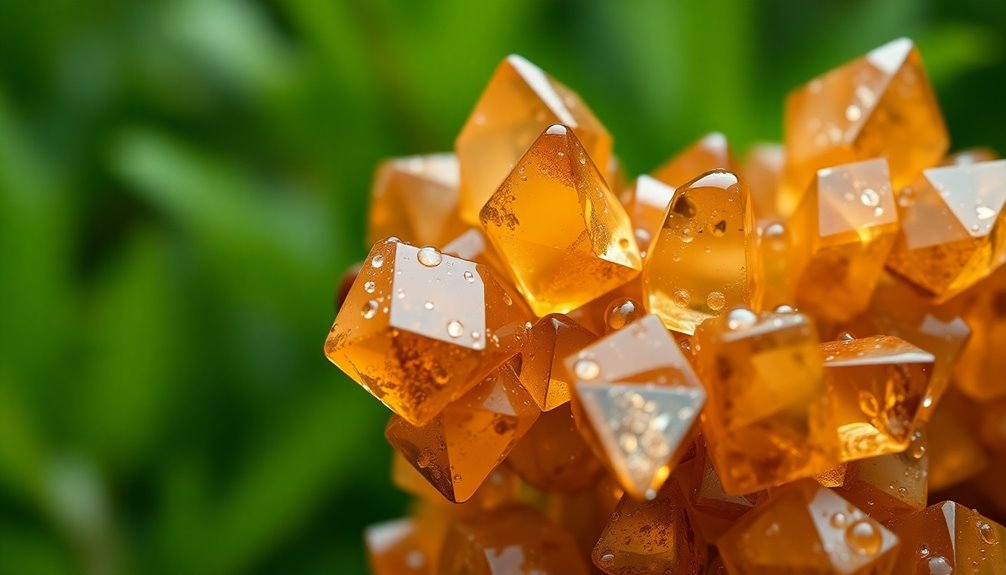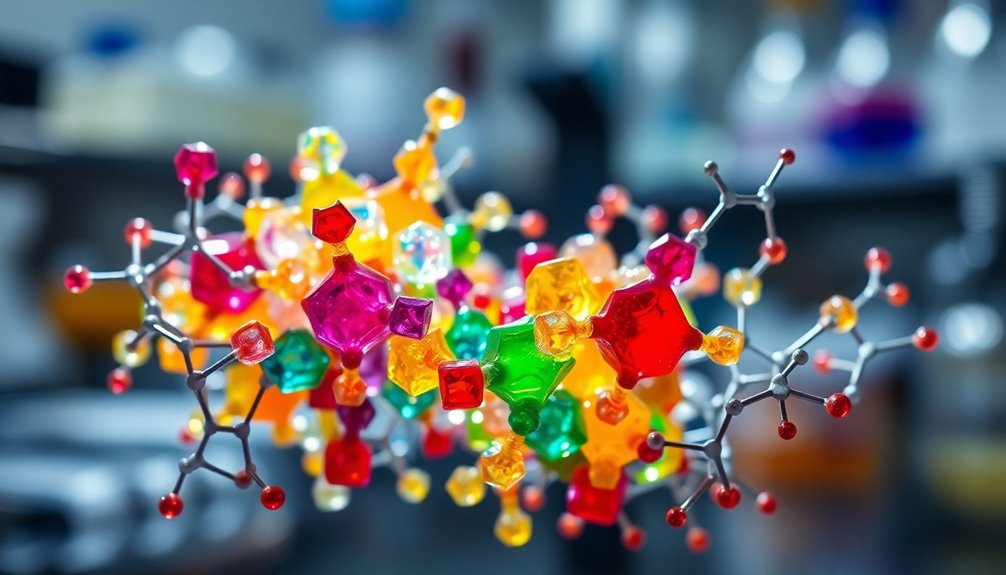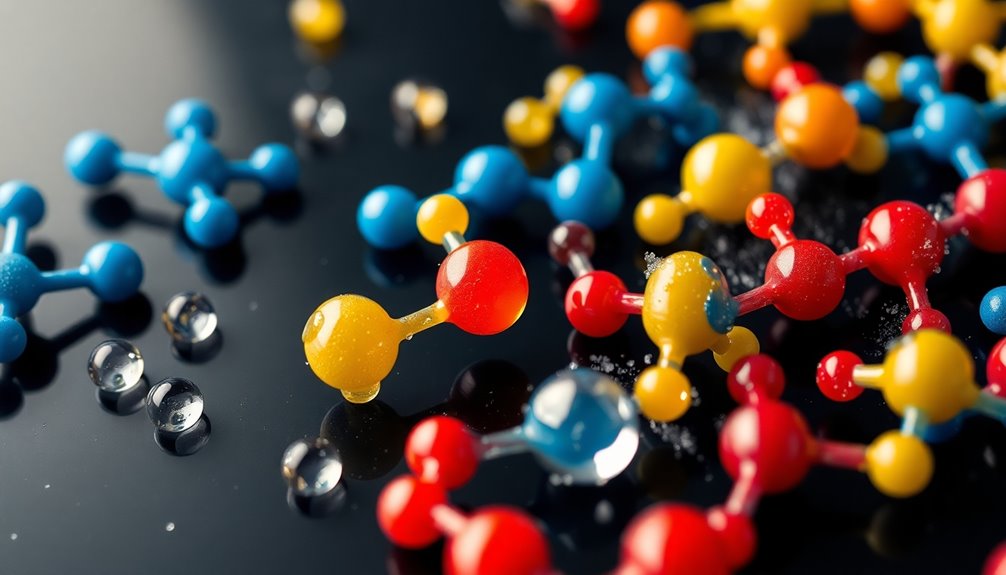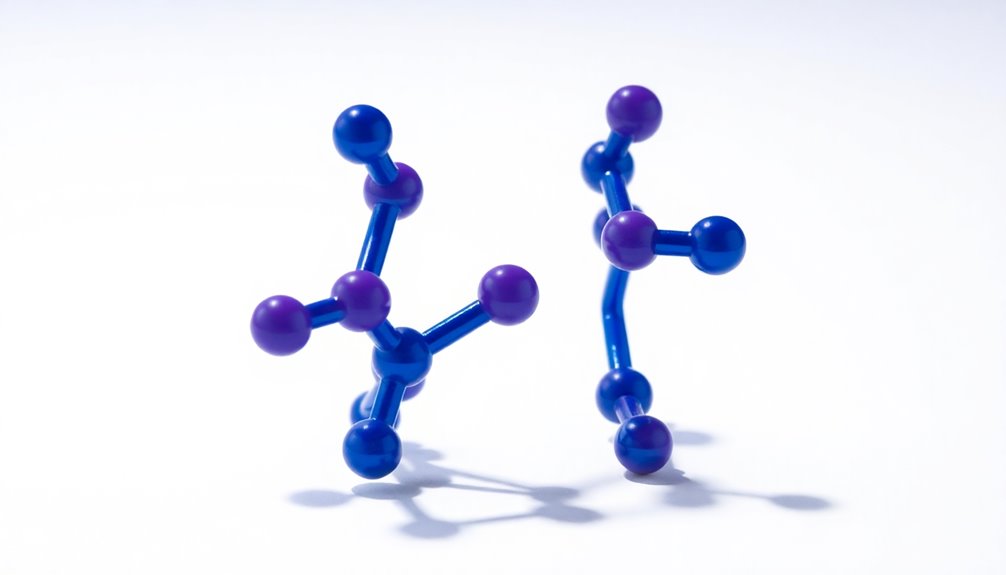Aromatic amino acids show varying degrees of polarity. Tyrosine is polar because it has a hydroxyl group that allows it to engage in hydrogen bonding with water. In contrast, phenylalanine and tryptophan are mostly nonpolar. Even though tryptophan has a polar nitrogen in its indole side chain, its hydrophobic ring makes it nonpolar overall. This difference in polarity affects where these amino acids are found in proteins, influencing their function. Understanding these characteristics can deepen your grasp of their roles in protein structure and stability. There's much more to discover about these fascinating molecules!
Key Takeaways
- Aromatic amino acids include phenylalanine, tyrosine, and tryptophan, with varying polarity characteristics.
- Tyrosine is polar due to its hydroxyl (-OH) group, enabling hydrogen bonding.
- Phenylalanine and tryptophan are generally classified as nonpolar due to their hydrophobic side chains.
- Tryptophan has a polar indole nitrogen but is predominantly nonpolar because of its hydrophobic ring structure.
- The polarity of aromatic amino acids influences their positioning in proteins, affecting stability and interactions.
Overview of Aromatic Amino Acids

Aromatic amino acids are fascinating components of proteins, known for their distinct aromatic ring structures. You'll find three main types: phenylalanine, tyrosine, and tryptophan.
Tyrosine stands out due to its polar hydroxyl group, allowing it to form hydrogen bonds, while phenylalanine and tryptophan are more nonpolar because of their hydrophobic rings.
These amino acids are vital for protein structure and function, helping stabilize folded structures and facilitating important interactions like protein-protein and protein-ligand binding.
Significantly, tryptophan absorbs UV light at a peak wavelength of 280 nm, making it valuable for studying proteins.
Polarity of Aromatic Side Chains

The characteristics of aromatic amino acids greatly influence their behavior in proteins, particularly when it comes to polarity. Most aromatic amino acids, like phenylalanine, tyrosine, and tryptophan, have nonpolar side chains due to their hydrophobic nature, primarily composed of carbon and hydrogen atoms.
However, tyrosine stands out with its polar hydroxyl (-OH) group, which enables it to form hydrogen bonds, adding to its polar characteristics. This polarity affects how these amino acids are distributed within proteins; nonpolar aromatic residues typically reside in the hydrophobic core, while polar ones like tyrosine often sit at the protein-solvent interface.
Recognizing the polarity of aromatic amino acids is essential for understanding their roles in protein structure and interactions.
Characteristics of Tyrosine

Tyrosine's chemical structure features a hydroxyl group that makes it polar, allowing it to interact well with water and other polar substances.
This property, combined with its aromatic ring, gives tyrosine unique characteristics that are essential for various biological functions.
You'll see how these polar and nonpolar properties play a role in its biochemical significance.
Chemical Structure Analysis
Characterized by its unique chemical structure, tyrosine possesses a phenolic hydroxyl (-OH) group attached to a benzene ring, which enhances its polar nature. This hydroxyl group allows tyrosine to participate in hydrogen bonding, improving its interactions with water and other polar molecules. Additionally, its side chain has a pKa of about 10.1, meaning it can be deprotonated under physiological conditions, further influencing its polarity and solubility.
| Feature | Description |
|---|---|
| Type | Aromatic amino acid |
| Functional Group | Hydroxyl (-OH) |
| pKa | Approximately 10.1 |
| UV Absorption Wavelength | ~274 nm |
| Role | Precursor to neurotransmitters |
Tyrosine's structure plays an essential role in its properties and functions.
Polar and Nonpolar Properties
Understanding tyrosine's polar and nonpolar properties reveals how its unique structure influences its behavior in biological systems.
Classified as a polar amino acid, tyrosine features a hydroxyl (-OH) group that allows it to form hydrogen bonds with water and other polar molecules. This polarity plays an essential role in stabilizing protein structure through hydrophilic interactions on the protein surface.
Additionally, the aromatic ring in tyrosine enables participation in both polar and nonpolar interactions, making it versatile within proteins.
Beyond its structural significance, tyrosine serves as a precursor for neurotransmitters and hormones, underscoring its importance in various biological processes.
Its ability to absorb UV light at 274 nm further highlights its unique characteristics in protein studies. Furthermore, herbal remedies that support overall health can enhance the effectiveness of tyrosine in promoting skin vitality and combating aging.
Characteristics of Tryptophan

Tryptophan stands out among amino acids for its unique structure and essential roles in the body. Classified as a nonpolar aromatic amino acid, its indole side chain features both hydrophobic elements and a nitrogen atom that can engage in hydrogen bonding. This dual nature contributes to protein structure, allowing tryptophan to influence how proteins fold and function.
Additionally, it absorbs UV light at 280 nm, making it valuable for quantifying protein concentration in studies. As a precursor to serotonin, tryptophan plays a key role in regulating mood and sleep patterns.
Since it's essential for human health, you must obtain it through dietary sources like meat, fish, dairy, and nuts to support your overall well-being.
Characteristics of Phenylalanine

Phenylalanine is one of the essential aromatic amino acids your body needs for proper functioning. It has a nonpolar side chain, which contributes to its hydrophobic nature. This characteristic means phenylalanine doesn't interact well with water, making it significant for the structural integrity of proteins.
You must obtain phenylalanine from dietary sources like meat, fish, eggs, and dairy, as your body can't produce it. It plays an important role in synthesizing neurotransmitters such as dopamine, norepinephrine, and epinephrine, which are key to mood and cognitive functions.
Additionally, your body can convert phenylalanine into tyrosine, another important amino acid. A deficiency can lead to phenylketonuria (PKU), a serious condition affecting metabolism and neurological health.
Impact of Polarity on Protein Function

When you look at aromatic amino acids, their unique ring structures play a vital role in protein stability.
These hydrophobic characteristics help proteins maintain their shape by promoting essential interactions within their cores.
Understanding how polarity influences these interactions can shed light on their impact on protein function and activity.
Aromatic Ring Characteristics
Aromatic rings in amino acids play an essential role in determining protein function due to their varying polarity. Aromatic amino acids like phenylalanine, tyrosine, and tryptophan exhibit different behaviors in proteins.
Tyrosine, with its hydroxyl group, is a polar aromatic residue capable of hydrogen bonding, making it vital for interactions at protein-solvent interfaces. In contrast, phenylalanine and tryptophan are largely nonpolar, leading to hydrophobic interactions. The positioning of these residues affects how proteins interact with other molecules.
Tryptophan also absorbs UV light at 280 nm, aiding in protein characterization. Additionally, aromatic side chains can engage in π-π stacking interactions, enhancing structural stability and facilitating binding in protein-ligand interactions. The understanding of aromatic amino acids is crucial for comprehending protein behavior in biological systems.
Protein Structural Stability
Understanding how polarity affects protein structural stability is vital for grasping protein function. Aromatic amino acids, like phenylalanine, tyrosine, and tryptophan, play an important role due to their unique properties.
While generally classified as nonpolar, tyrosine's polar functional groups allow it to form hydrogen bonds, enhancing stability in aqueous environments. These amino acids contribute to protein structure through pi-pi stacking and hydrophobic effects, which are essential for proper protein folding.
Their strategic placement within protein cores or at binding interfaces maintains structural integrity and facilitates interactions with ligands or other proteins. Ultimately, the characteristics of aromatic amino acids greatly impact protein functionality, reinforcing the importance of understanding their role in protein structural stability.
Role in Enzyme Activity

The role of aromatic amino acids in enzyme activity is essential, as they not only stabilize protein structures but also enhance catalytic efficiency.
Here are three key ways they contribute:
- Hydrophobic interactions: Their nonpolar nature allows them to stabilize enzyme structures, promoting proper folding.
- Substrate binding: Aromatic amino acids in the enzyme active sites facilitate specific interactions that improve substrate recognition.
- Kinetic influence: Tryptophan's ability to absorb UV light aids in analyzing enzyme activities, providing insights into their kinetics.
Aromatic Amino Acids in Peptide Design

When designing peptides, incorporating aromatic amino acids like phenylalanine, tyrosine, and tryptophan can considerably enhance their structural stability and functional properties.
These amino acids, known for their bulky aromatic side chains, contribute to the hydrophobic core of proteins, providing stability through π-π stacking interactions.
Tyrosine and tryptophan's polar functional groups enable them to engage in hydrogen bonding, which is essential in aqueous environments during peptide synthesis.
By strategically placing these aromatic amino acids in peptide sequences, you can improve binding affinity and specificity for targets, leveraging their unique interactions with biomolecules.
Additionally, their UV absorbance properties allow for effective monitoring of peptide synthesis and protein concentration, further emphasizing their importance in peptide design.
Summary of Aromatic Polarity

Aromatic amino acids play an essential role in determining protein polarity and functionality. Understanding their polarity can help you predict interactions within protein structures.
Here are three key points to reflect upon:
- Tyrosine is a polar amino acid due to its hydroxyl (-OH) group, allowing it to form hydrogen bonds.
- Phenylalanine and tryptophan are generally classified as nonpolar, with tryptophan having a polar indole nitrogen but dominated by its hydrophobic aromatic ring.
- The location of these aromatic amino acids influences protein structure, with polar amino acids often situated on the surface for interaction with the aqueous environment, while nonpolar ones reside in the core.
Grasping the polarity of aromatic amino acids is crucial for understanding their biochemical roles.
Frequently Asked Questions
Are the Aromatic Amino Acids Nonpolar?
Yes, aromatic amino acids are generally considered nonpolar. Their side chains, featuring aromatic rings, primarily exhibit hydrophobic characteristics.
For instance, phenylalanine is the most hydrophobic, while tryptophan, despite having a nitrogen atom, remains nonpolar due to its overall hydrophobic nature.
Tyrosine has a polar hydroxyl group, but its aromatic ring still dominates, classifying it as nonpolar in most situations.
This nonpolarity helps stabilize protein structures through hydrophobic interactions.
Are Aromatic Amino Acids Hydrophobic or Hydrophilic?
As the saying goes, "Don't judge a book by its cover."
Aromatic amino acids are primarily hydrophobic due to their nonpolar aromatic side chains, which shy away from water. While they generally avoid interactions with water, tyrosine stands out with its hydroxyl group, offering some polar characteristics.
This complexity shows that while many aromatic amino acids are hydrophobic, they also possess unique properties that allow for limited interactions in biological systems.
What Types of Amino Acids Are Polar?
When you think about polar amino acids, you're looking at those with side chains that contain electronegative atoms.
These include Serine, Threonine, Asparagine, Glutamine, and Tyrosine. Each of them can form hydrogen bonds, enhancing their ability to interact with water.
Cysteine's thiol group makes it polar, but it can act nonpolar in certain situations.
Understanding these amino acids is essential, as they influence protein function and stability considerably.
Is ASP Polar or Nonpolar?
Aspartate is polar due to its negatively charged carboxyl side chain, which makes it soluble in water.
You'll notice that this amino acid can form hydrogen bonds with water and other polar molecules, enhancing its interactions in various biochemical processes.
Its polarity allows it to engage effectively in metabolic pathways and enzyme catalysis, stabilizing charged intermediates.
Conclusion
In conclusion, aromatic amino acids dance between polar and nonpolar domains, each bringing unique characteristics to the table. Tyrosine, tryptophan, and phenylalanine play vital roles in protein function and enzyme activity, like musicians in a symphony, harmonizing to create a vibrant melody of biological processes. Understanding their polarity not only enhances peptide design but also deepens your appreciation for the intricate roles these amino acids play in life's grand performance.










